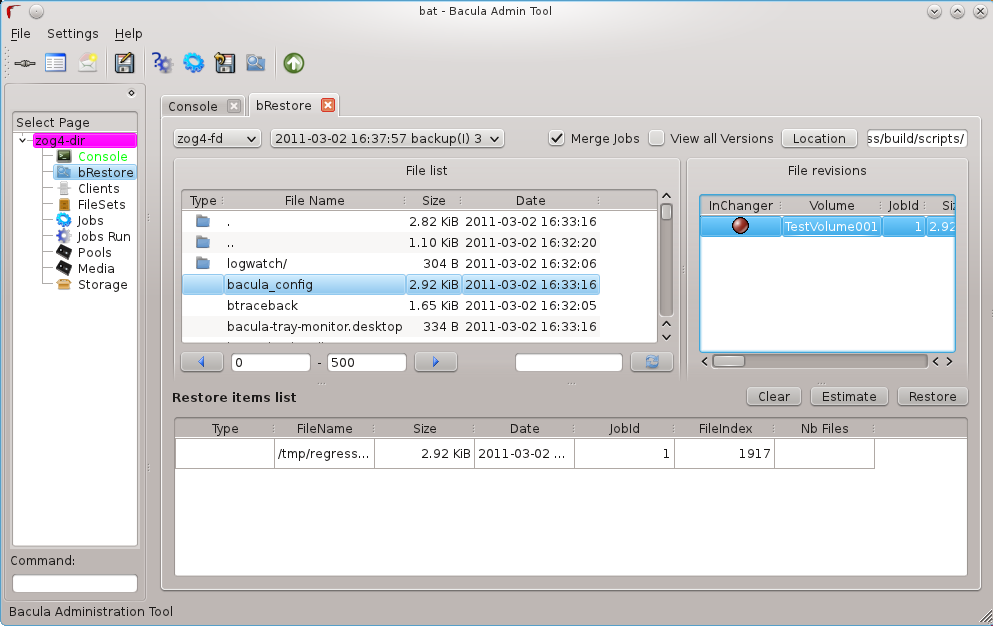

Implementing a GUI Interface
General
This document is intended mostly for developers who wish to develop a new GUI interface to Bacula.
Minimal Code in Console Program
Until now, I have kept all the Catalog code in the Directory (with the exception of dbcheck and bscan). This is because at some point I would like to add user level security and access. If we have code spread everywhere such as in a GUI this will be more difficult. The other advantage is that any code you add to the Director is automatically available to both the tty console program and the WX program. The major disadvantage is it increases the size of the code - however, compared to Networker the Bacula Director is really tiny.
GUI Interface is Difficult
Interfacing to an interactive program such as Bacula can be very difficult because the interfacing program must interpret all the prompts that may come. This can be next to impossible. There are are a number of ways that Bacula is designed to facilitate this:
- The Bacula network protocol is packet based, and thus pieces of information sent can be ASCII or binary.
- The packet interface permits knowing where the end of a list is.
- The packet interface permits special “signals” to be passed rather than data.
- The Director has a number of commands that are non-interactive. They all begin with a period, and provide things such as the list of all Jobs, list of all Clients, list of all Pools, list of all Storage, ... Thus the GUI interface can get to virtually all information that the Director has in a deterministic way. See <bacula-source>/src/dird/ua_dotcmds.c for more details on this.
- Most console commands allow all the arguments to be specified on the command line: e.g. run job=NightlyBackup level=Full command
One of the first things to overcome is to be able to establish a conversation with the Director. Although you can write all your own code, it is probably easier to use the Bacula subroutines. The following code is used by the Console program to begin a conversation.
static BSOCK *UA_sock = NULL;
static JCR *jcr;
...
read-your-config-getting-address-and-pasword;
UA_sock = bnet_connect(NULL, 5, 15, "Director daemon", dir->address,
NULL, dir->DIRport, 0);
if (UA_sock == NULL) {
terminate_console(0);
return 1;
}
jcr.dir_bsock = UA_sock;
if (!authenticate_director(\&jcr, dir)) {
fprintf(stderr, "ERR=%s", UA_sock->msg);
terminate_console(0);
return 1;
}
read_and_process_input(stdin, UA_sock);
if (UA_sock) {
bnet_sig(UA_sock, BNET_TERMINATE); /* send EOF */
bnet_close(UA_sock);
}
exit 0;
Then the read_and_process_input routine looks like the following:
get-input-to-send-to-the-Director; bnet_fsend(UA_sock, "%s", input); stat = bnet_recv(UA_sock); process-output-from-the-Director;
For a GUI program things will be a bit more complicated. Basically in the very inner loop, you will need to check and see if any output is available on the UA_sock. For an example, please take a look at the WX GUI interface code in: <bacula-source/src/wx-console
Bvfs API
To help developers of restore GUI interfaces, we have added new dot commands that permit browsing the catalog in a very simple way.
Bat has now a bRestore panel that uses Bvfs to display files and directories.
The Bvfs module works correctly with BaseJobs, Copy and Migration jobs.
This project was funded by Bacula Systems.
General notes
- All fields are separated by a tab
- You can specify limit= and offset= to quickly obtain partial listings big directories.
- All operations (except cache creation) are designed to run very fast.
- The cache creation depends on the number of directories, and since Bvfs shares information across jobs, the first creation can take some time.
- All fields returned are separated by a tab.
- Due to potential filename encoding problems, we recommend to always use pathid in queries.
Get dependent jobs from a given JobId
Bvfs allows you to query the catalog against any combination of jobs. You can combine all Jobs and all FileSet for a Client in a single session.
To get all JobId needed to restore a particular job, you can use the .bvfs_get_jobids command command.
.bvfs_get_jobids jobid=num [all]
.bvfs_get_jobids jobid=10 1,2,5,10 .bvfs_get_jobids jobid=10 all 1,2,3,5,10
In this example, a normal restore will need to use JobIds 1,2,5,10 to compute a complete restore of the system.
With the all option, the Director will use all defined FileSet for this client.
Delete a Catalog File Record
In some cases, it is possible to delete a specific File record with the .bvfs_delete_fileid command..bvfs_delete_fileid jobid=num fileid=num
Generating Bvfs cache
The .bvfs_update command command computes the directory cache for jobs specified in argument, or for all jobs if unspecified.
.bvfs_update [jobid=numlist]
Example:
.bvfs_update jobid=1,2,3
You can run the cache update process in a RunScript after the catalog backup.
Get all versions of a specific file
Bvfs allows you to find all versions of a specific file for a given Client with the .bvfs_version command command. To avoid problems with encoding, this function uses only PathId and FilenameId. The jobid argument is mandatory but unused.
.bvfs_versions client=filedaemon pathid=num filenameid=num jobid=1 PathId FilenameId FileId JobId LStat Md5 VolName Inchanger PathId FilenameId FileId JobId LStat Md5 VolName Inchanger ...
Example:
.bvfs_versions client=localhost-fd pathid=1 fnid=47 jobid=1 1 47 52 12 gD HRid IGk D Po Po A P BAA I A /uPgWaxMgKZlnMti7LChyA Vol1 1
List directories
Bvfs allows you to list directories in a specific path.
.bvfs_lsdirs pathid=num path=/apath jobid=numlist limit=num offset=num PathId FilenameId FileId JobId LStat Path PathId FilenameId FileId JobId LStat Path PathId FilenameId FileId JobId LStat Path ...
You need to pathid or path. Using path="" will list “/” on Unix and all drives on Windows. If FilenameId is 0, the record listed is a directory.
.bvfs_lsdirs pathid=4 jobid=1,11,12 4 0 0 0 A A A A A A A A A A A A A A . 5 0 0 0 A A A A A A A A A A A A A A .. 3 0 0 0 A A A A A A A A A A A A A A regress/
In this example, to list directories present in regress/, you can use
.bvfs_lsdirs pathid=3 jobid=1,11,12 3 0 0 0 A A A A A A A A A A A A A A . 4 0 0 0 A A A A A A A A A A A A A A .. 2 0 0 0 A A A A A A A A A A A A A A tmp/
List files
Bvfs allows you to list files in a specific path.
.bvfs_lsfiles pathid=num path=/apath jobid=numlist limit=num offset=num PathId FilenameId FileId JobId LStat Path PathId FilenameId FileId JobId LStat Path PathId FilenameId FileId JobId LStat Path ...
You need to pathid or path. Using path="" will list “/” on Unix and all drives on Windows. If FilenameId is 0, the record listed is a directory.
.bvfs_lsfiles pathid=4 jobid=1,11,12 4 0 0 0 A A A A A A A A A A A A A A . 5 0 0 0 A A A A A A A A A A A A A A .. 1 0 0 0 A A A A A A A A A A A A A A regress/
In this example, to list files present in regress/, you can use
.bvfs_lsfiles pathid=1 jobid=1,11,12 1 47 52 12 gD HRid IGk BAA I BMqcPH BMqcPE BMqe+t A titi 1 49 53 12 gD HRid IGk BAA I BMqe/K BMqcPE BMqe+t B toto 1 48 54 12 gD HRie IGk BAA I BMqcPH BMqcPE BMqe+3 A tutu 1 45 55 12 gD HRid IGk BAA I BMqe/K BMqcPE BMqe+t B ficheriro1.txt 1 46 56 12 gD HRie IGk BAA I BMqe/K BMqcPE BMqe+3 D ficheriro2.txt
In this example, we list all files present in a given job
.bvfs_lsfiles allfiles jobid=1 83 1 1 1 m BDPE IGk B Po Bk A t1 BAA I BiQWDy BiQWDy BiQWDy A A G /tmp/regress/build/config.out 83 2 2 1 m BDO4 IHt B Po Bk A BI5j BAA JI BiQWEB BiQWDk BiQWDk A A G /tmp/regress/build/libtool 83 3 3 1 m BDMV IGk B Po Bk A CsI BAA Y BiQWEB BiQWDi BiQWDi A A G /tmp/regress/build/Makefile 83 4 4 1 m BDMI IHt B Po Bk A aaw BAA DY BiQWDk BiQWDh BiQWDh A A G /tmp/regress/build/config.status 83 5 5 1 m BDIx IGk B Po Bk A XZj BAA DA BiQWDf BiQWDy BiQWDy A A G /tmp/regress/build/config.log
Restore set of files
Bvfs allows you to create a SQL table that contains files (as well as plugin objects) that you want to restore. This table can be provided to a restore command with the file option.
.bvfs_restore fileid=numlist dirid=numlist path=b2num objectid=numlist OK restore file=?b2num ...
To include a directory (with dirid), Bvfs needs to run a query to select all files. This query could be time consuming.
The path argument represents the name of the table that Bvfs will store results. The format of this table is b2[0-9]+. (Should start by b2 and followed by digits).
Example:
.bvfs_restore fileid=1,2,3,4 jobid=10 path=b20001 objectid=1,2,3 OK
Cleanup after Restore
To drop the table used by the restore command, you can use the .bvfs_cleanup command command.
.bvfs_cleanup path=b20001
Clearing the BVFS Cache
To clear the BVFS cache, you can use the .bvfs_clear_cache command command.
.bvfs_clear_cache yes OK
Decode the LStat Attribute
*.bvfs_decode_lstat lstat="A A IHA A A A A A BAA B BXTDon BXTDon BXTDon A A C" st_nlink=0 st_mode=33216 st_uid=0 st_gid=0 st_size=0 st_blocks=1 st_ino=0 st_ctime=1464613415 st_mtime=1464613415 st_atime=1464613415 st_dev=0 LinkFI=0
